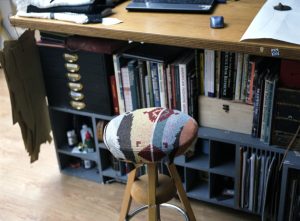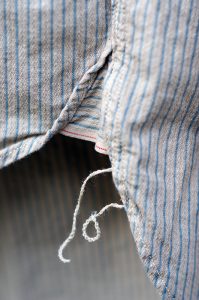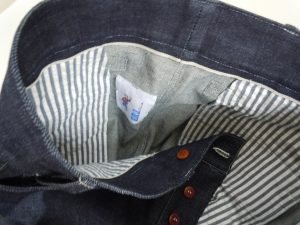Given that Neil is British and Akimi is Japanese, it may not be a total surprise that their combined output fits very well into the Anglo-Japanese movement that is so strong these days. ARN is a tiny company in the UK, but sells most of its product in Japan, Germany and the US. British heritage is very strong in Japan and Germany, and Japan has a lot to offer the rest of the world when it comes to the technical and quality side of things.

ARN’s profile fits quite strongly within work wear, though they combine English/European work wear with a 1920′s US influence. Quality and construction of the garments is paramount, as is the selection of the materials used. They try to make things that change with wear as well as work with the idea of movement and shape. While Neil is a big fan of vintage design, he is keen to stress that they are not a company in the business of reproducing vintage designs. For the most part, fabrics are produced in Japan, whilst the actual production is now done in their own workshop.
The roles in ARN are quite clear cut, so to speak, with Neil being the pattern cutter and Akimi the fabric technician, sourcing and selecting the fabrics. Given that they are primarily a 2 person operation both also act as designers, and share all other tasks. The fabrics used are strictly Fair Trade and only organically grown cottons are used. The stated ambition is to produce eco-friendly garments, through a combination of ensuring production is as eco-friendly as possible, and that the clothes have a long life cycle. Quite the contrast to how most high-street garments today are produced with maximum profit and rapid seasonal turnaround as their main principles.
speak, with Neil being the pattern cutter and Akimi the fabric technician, sourcing and selecting the fabrics. Given that they are primarily a 2 person operation both also act as designers, and share all other tasks. The fabrics used are strictly Fair Trade and only organically grown cottons are used. The stated ambition is to produce eco-friendly garments, through a combination of ensuring production is as eco-friendly as possible, and that the clothes have a long life cycle. Quite the contrast to how most high-street garments today are produced with maximum profit and rapid seasonal turnaround as their main principles.

Neil has been involved in the garment industry since age 12, when he went to work at the corset factory his father ran. Starting out in the cutting room, observing the way the garments were built up, from flat fabric to a fully 3D garment, he early on developed a fascination with disassembling and assembling things. During a period in the US, he set up a small factory with some others and learnt how to construct garments by taking apart older garments. A thorough learning process, and a obvious starting point for the work wear style that is the mainstay of what he does today. Since then he has also worked for Nike, Carhartt, Levi and a few others, but vastly prefers the smaller and more personal situation he is in now.
Akimi’s history is more in the building of cloths, working in Osaka, the centre of fabric and denim weaving in Japan. Given their complimentary backgrounds, it’s no wonder their combined skills produce garments of such great quality and design.
The ARN workshop has, until they recently acquired a separate workshop, also been the family home. This was intentional, so as to be able to spend more time together as a family. This also influences which shows they attend to show their garments, preferring the child-friendly ones of those that are less so. Again, this shows their caring nature, a rarity in today’s cut-throat economic era.






